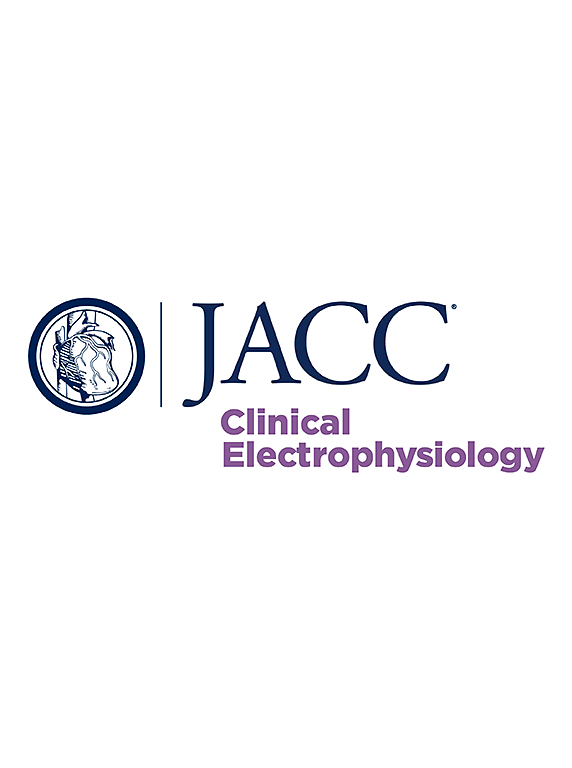脉冲场与热导管消融对肥厚性心肌病患者心房颤动的影响。
IF 7.7
1区 医学
Q1 CARDIAC & CARDIOVASCULAR SYSTEMS
引用次数: 0
摘要
背景:脉冲场消融(PFA)可能有利于治疗肥厚性心肌病(HCM)患者的心房颤动(AF)。目的:本研究的目的是比较PFA和热消融在HCM和AF患者中的安全性和有效性。方法:从2016年到2024年,回顾性纳入来自法国和瑞士3个中心的HCM患者,他们首次使用PFA或热消融(低温球囊或射频)进行房颤消融。随访12个月,评估房性心律失常(AA)复发情况。结果:109例患者(中位年龄60岁;男性68%;43%的阵发性房颤合并HCM患者接受了PFA (n = 58)或热消融(n = 51)治疗房颤。除肺静脉(PV)隔离外,62%的PFA病例和18%的热消融病例接受了PV外消融治疗。与热消融相比,PFA的中位手术时间更短(81分钟[Q1-Q3: 60-110分钟]vs 132分钟[Q1-Q3: 75-190分钟];P < 0.0001),术后心力衰竭较少(n = 0 vs n = 4;p = 0.03)。12个月后AA复发自由率为57% (95% CI: 46%-67%)。与热消融相比,PFA的AA复发率更低(校正HR: 0.46;95% ci: 0.23-0.91;p = 0.03)。pv外消融与热消融的AA复发相关(风险比:3.07;95% ci: 1.21-7.82;P = 0.02),但与PFA无关(HR: 1.07;95% ci: 0.35-3.27;p = 0.91)。结论:在HCM和房颤患者中,PFA似乎比热消融具有更好的安全性和有效性。本文章由计算机程序翻译,如有差异,请以英文原文为准。
Pulsed-Field vs Thermal Catheter Ablation of Atrial Fibrillation in Patients With Hypertrophic Cardiomyopathy
Background
Pulsed-field ablation (PFA) may be beneficial for the treatment of atrial fibrillation (AF) in patients with hypertrophic cardiomyopathy (HCM).
Objectives
The goal of this study was to compare the safety and efficacy of PFA and thermal ablation in patients with HCM and AF.
Methods
From 2016 to 2024, patients with HCM undergoing a first AF ablation using PFA or thermal ablation (cryoballoon or radiofrequency) were retrospectively included from 3 French and Swiss centers. Freedom from atrial arrhythmia (AA) recurrence at the 12-month follow-up was assessed.
Results
Overall, 109 patients (median age 60 years; 68% male; 43% paroxysmal AF) with HCM underwent PFA (n = 58) or thermal ablation (n = 51) of AF. In addition to pulmonary vein (PV) isolation, extra-PV ablation was performed in 62% of PFA cases and in 18% of thermal cases. PFA was associated with shorter median procedure times than thermal ablation (81 minutes [Q1-Q3: 60-110 minutes] vs 132 minutes [Q1-Q3: 75-190 minutes]; P < 0.0001) and with less postprocedural heart failure (n = 0 vs n = 4; P = 0.03). Freedom from AA recurrence was 57% (95% CI: 46%-67%) after 12 months. PFA was associated with less AA recurrence than thermal ablation (adjusted HR: 0.46; 95% CI: 0.23-0.91; P = 0.03). Extra-PV ablation was associated with more sustained AA recurrence with thermal ablation (HR: 3.07; 95% CI: 1.21-7.82; P = 0.02) but not with PFA (HR: 1.07; 95% CI: 0.35-3.27; P = 0.91).
Conclusions
In patients with HCM and AF, PFA seems to be associated with better safety and efficacy outcomes than thermal ablation.
求助全文
通过发布文献求助,成功后即可免费获取论文全文。
去求助
来源期刊

JACC. Clinical electrophysiology
CARDIAC & CARDIOVASCULAR SYSTEMS-
CiteScore
10.30
自引率
5.70%
发文量
250
期刊介绍:
JACC: Clinical Electrophysiology is one of a family of specialist journals launched by the renowned Journal of the American College of Cardiology (JACC). It encompasses all aspects of the epidemiology, pathogenesis, diagnosis and treatment of cardiac arrhythmias. Submissions of original research and state-of-the-art reviews from cardiology, cardiovascular surgery, neurology, outcomes research, and related fields are encouraged. Experimental and preclinical work that directly relates to diagnostic or therapeutic interventions are also encouraged. In general, case reports will not be considered for publication.
 求助内容:
求助内容: 应助结果提醒方式:
应助结果提醒方式:


